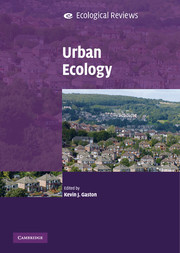Book contents
- Frontmatter
- Contents
- List of contributors
- Preface
- 1 Urban ecology
- 2 Urbanisation
- 3 Urban environments and ecosystem functions
- 4 Individual species and urbanisation
- 5 Species diversity and urbanisation: patterns, drivers and implications
- 6 Urbanisation and alien invasion
- 7 Interactions between people and nature in urban environments
- 8 Urban ecology and human social organisation
- 9 Urban ecology and human health and wellbeing
- 10 Bringing cities alive: the importance of urban green spaces for people and biodiversity
- 11 Integrating nature values in urban planning and design
- 12 Urban futures
- Index
- References
9 - Urban ecology and human health and wellbeing
Published online by Cambridge University Press: 05 June 2012
- Frontmatter
- Contents
- List of contributors
- Preface
- 1 Urban ecology
- 2 Urbanisation
- 3 Urban environments and ecosystem functions
- 4 Individual species and urbanisation
- 5 Species diversity and urbanisation: patterns, drivers and implications
- 6 Urbanisation and alien invasion
- 7 Interactions between people and nature in urban environments
- 8 Urban ecology and human social organisation
- 9 Urban ecology and human health and wellbeing
- 10 Bringing cities alive: the importance of urban green spaces for people and biodiversity
- 11 Integrating nature values in urban planning and design
- 12 Urban futures
- Index
- References
Summary
The importance of urban greening
Westernised societies are becoming more and more urbanised, and throughout the twentieth and twenty-first centuries the number of people living in urban settings has steadily increased. More than half of the world's population currently live in urban areas (UNFPA 2007) and this proportion is still set to increase (Pretty 2007). Urban environments expose people to many stressors, such as traffic noise and congestion, crowding and fear of crime, and are often a source of continual demands prohibiting restoration from mental fatigue (van den Berg et al. 2007). Everyday life revolves around complex information processing activities requiring directed attention (Kaplan & Kaplan 1989). Our capacity for this type of concentrated attention is finite, so it is regularly taxed to its limit, leading to mental fatigue. This is a state characterised by inattentiveness, indecisiveness and increased irritability, and we have fewer cognitive resources available to manage everyday tasks, leading to increased stress (Kaplan 1995). To restore our capacity for directed attention, we need to spend time in settings that utilise involuntary attention requiring no cognitive effort. Having contact with nature and green spaces promotes this type of attention restoration, alleviates fatigue and reduces stress. Thus, with ongoing urban and suburban sprawl, the importance of access to nearby nature is paramount, especially for those regularly exposed to the pressures of urban life.
- Type
- Chapter
- Information
- Urban Ecology , pp. 202 - 229Publisher: Cambridge University PressPrint publication year: 2010
References
- 16
- Cited by



